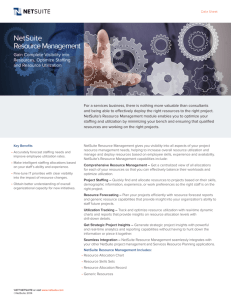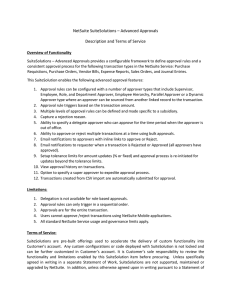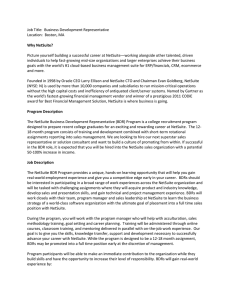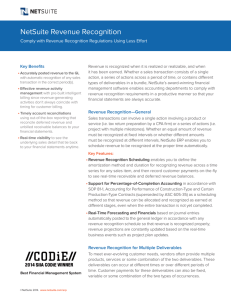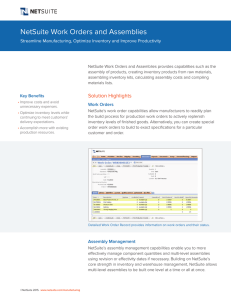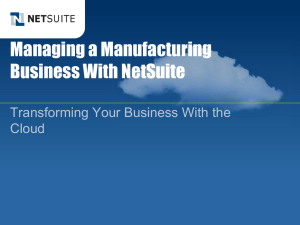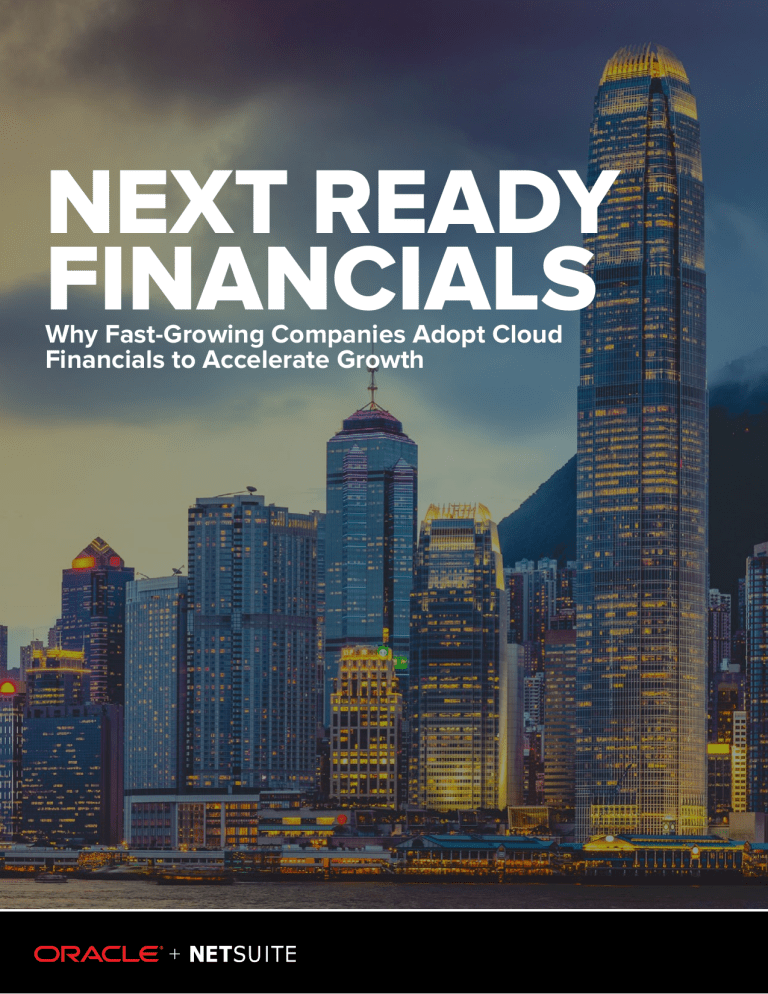
NEXT READY FINANCIALS Why Fast-Growing Companies Adopt Cloud Financials to Accelerate Growth Grab a seat and enjoy. Read Time: 18 minutes NEXT READY FINANCIALS Why Fast-Growing Companies Adopt Cloud Financials to Accelerate Growth Introduction Over the years, small to midsized businesses have pieced together a patchwork of applications to run their operations. From accounting to order fulfilment, to sales and marketing, a venerable hairball of applications exists across millions of small to midsized business. This infrastructure will not enable rapidly growing businesses to sustain and accelerate growth. Piecing together various applications to effectively run your business is inadequate. This approach lacks many of the capabilities that growing businesses need and provides Copyright © 2017, Oracle and/or its affiliates. All rights reserved. minimal real-time visibility into essential business information. Unfortunately, this strategy results in companies trying to grow by adding even more systems or applications for specific purposes—which often aren’t integrated with each other—and may revise or attempt to automate certain business processes. This application hairball results in a level of complexity that’s rife with manual tasks and bottlenecks, increases risks and errors, and can hurt the customer experience. In fact, it hinders growth and in some cases, it can result in the death of a once vibrant company. Page 2 “Splunk is a growing, global company. We are running on one application [NetSuite], which allows us to spend our time drilling down into and analyzing data and maximizing performance, instead of copying and combining data from different sources and systems.” — Doug Harr, CIO, Splunk For years, NetSuite has worked with growing business across all industries and geographies, and with thousands of finance and IT professionals guiding their companies through different phases of development. While these businesses are diverse, they experience similar challenges in dealing with traditional, on-premise systems. Following is a summary of many of the issues that growing companies typically face, and why so many have decided to move to NetSuite—a Next Ready, modern, integrated, cloud-based solution that enables Copyright © 2017, Oracle and/or its affiliates. All rights reserved. accelerated business growth. Case studies and quotes from those who have adopted NetSuite describe why their companies made the decision, how they have implemented NetSuite and the benefits they are experiencing. If you are leading a growing business, and are concerned that the pain and complexity imposed by an application hairball that is limiting your business, read on to discover that you are not alone—and that there is a better way! Page 3 An integrated cloud- based system overcomes business limitations both known and unknown. Five triggers that indicate systems and applications are failing our business Running complex business processes across areas such as financial management, revenue management, fixed assets, procurement, order management, billing, inventory management, services delivery and more is not possible with disparate systems and applications, from a simple general ledger solution patched together with a web store, warehouse management application and a customer support system, this solution simply will not support your growing company and business processes. Moving to a single, integrated cloud-based system is a better solution (as the quotes that follow indicate), but companies may not recognize signs that an application hairball is limiting the business due to manual processes, errors and lack of real-time data and visibility to make important business decisions. Here are five triggers that serve as red flags: Copyright © 2017, Oracle and/or its affiliates. All rights reserved. 1 It’s difficult to find out what’s really happening across the business in real-time. Most systems are designed for an era when companies could wait until the end of the month to get the data they need. That’s not the case today—consolidated views and up-tothe-minute reporting can make the difference between thriving and barely surviving. Small teams at a single location can sometimes get by without a fully automated system because they are close enough to the action. But as a company begins to grow or takes on new locations, the information that has to be exchanged increases exponentially. Additionally, the data needed for timely and accurate business decisions is buried within your disparate systems from sales force automation system, inventory management applications and customer service systems. Page 4 Here are several symptoms that your management reporting isn’t meeting the organization’s needs: • Team members waste time playing playing “Hunt for the Spreadsheet”. Growing businesses inevitably reach a stage where employees rely on spreadsheets to fill the information gap, since data lives in so many disparate systems. People end up spending more time hunting for data than actually analyzing it and making decisions. • Management reports are error-prone and out-of-date. As businesses grow, they may use multiple manual processes to augment a less-than-optimum infrastructure. They may rekey sales orders into their financial system, reconcile customer information manually or manage SKUs across multiple systems. Reporting errors are inevitable and decisions are often made based on out-of-date, incomplete or inaccurate information. • Reports take too long to run. With disparate systems, it’s easy to hit performance bottlenecks but solving them is more difficult. When reports take too long to run, it’s a sign that the amount of data the business has amassed has grown too large for a patchwork of applications to report on it. • It is impossible to get a comprehensive view across all business units. As businesses grow over time, they usually have one set of financials in a standalone ledger system, while financial data for newer geographic locations or divisions ends up in other installations or financial products. Moving data between systems is usually manual Copyright © 2017, Oracle and/or its affiliates. All rights reserved. and can result in errors. Additionally, management teams lack insight into how the business is performing on a holistic level. 2 Manual processes are used to entering and reconciling data across systems. In today’s “need it now” networked world, it is frustrating for suppliers, customers and business managers to wait for answers while information is manually transferred between systems. Incompatibilities between systems and imperfect integration have left employees copying data between systems. These symptoms are a sign that it may be time for your business to transition to a next ready single platform cloud solution like NetSuite: • Sales orders, order entry and invoicing are paper-based. Your employees may spend hours every week manually entering order information into the invoicing system, while someone else copies invoice details into a sales compensation spreadsheet. Data entry errors lead to invoice queries that must be resolved, and month-end crises are on the rise. • Bad customer information results in unhappy customers. When some customer information resides in sales spreadsheets, while some is stored in standalone financial systems and other applications, there is no way to know which data is most current, accurate and reliable. Bills may be sent to the wrong customer address or contact information may be out-of-date. Page 5 • Approval processes are slow and disjointed. When people have to pass paperwork around or match it up to information stored in separate software applications, simple processes like expense claim approvals or routine contract signatures can take days or weeks to finalize. • Financial consolidation takes ages. Crossposting transactional data between systems is time-consuming and the finance team works late every month to consolidate financial reports. Yet as hard as they work, managers are still unhappy because their weekly and monthly reports are delayed. • Sales forecasting and budgeting processes rely on guesswork, rather than facts. Since it is difficult to get historic information in the right format in a timely manner to do trend analysis, employees put figures in spreadsheets based on guesswork. Even though the actual data exists somewhere, it’s too hard to find and extract. 3 Sales are lost because employees can’t get information to where it is needed fast enough. Ecommerce has set the standard for customers these days. They expect to see real-time stock levels, confirm delivery schedules at the same time they place their order, and call customer service minutes after placing an order to add an extra line item. But this level of real-time responsiveness is impossible with limited or disparate systems. Copyright © 2017, Oracle and/or its affiliates. All rights reserved. Growing businesses can’t expect to creak along, while others fly at on-demand speed. Here are some warning signs that reliance on disparate systems may be costing you sales: • Customer service fails because agents don’t have up-to-date information. When customers call to place orders or check order status, it is frustrating to be kept on hold or called back with an answer. This often happens when information has to be retrieved from someone in another department or location. Customers may not file direct complaints, but churn and abandonment figures rise as customers find other vendors that don’t waste their time. • Stock levels are never where customers want them. Common symptoms are running out of stock at some outlets, while the same SKU sits on shelves elsewhere. It is impossible to pre-empt outages because it takes too long to update and consolidate point-of-sales data. In addition, real-time access to trend analysis by SKU and outlet isn’t available. • Customers and vendors don’t have access to self-service information on your website. Customers have asked for the ability to look up stock, place orders and check status on the web, but you can’t justify the required investment of time and money. In addition, your current business system wasn’t designed to operate 24x7 and it’s not clear it could be kept secure against online threats. Page 6 • Customer information can’t be easily collected or filtered for sales campaigns. Even though the company is sending out regular email campaigns, the sales team has no information about responses when they call prospects and conversion rates are low. Unsold inventory is a problem because there just isn’t time to organize a sales push or mailshot to clear the excess products. 4 More accounting is done outside of the financial system than in it. Standalone financial systems are designed to automate a limited set of core accounting functions. As a result, it limits how companies can run their operations. As businesses grow, companies must adapt their processes to fit the application, rather than having a system that is scalable and will accommodate growth. It is easy to run out of headroom when companies have more customers, vendors or inventory items than many standalone financial systems can practically handle. The key to business growth and success is greater transaction volumes and speed, but it’s hard for many financial systems to handle this kind of pressure. Full audit trails, rich business planning and reporting or automated processes mean having to add systems and constantly engineer short-term quick fixes. Standalone financial systems simply can’t Copyright © 2017, Oracle and/or its affiliates. All rights reserved. handle stronger financial controls, better SKU management or support for more complex financial processes, such as recurring billing and invoicing. Here are some signals that an organization has reached its financial system’s limits: • Finance staff members must use several different applications to do their jobs. As the firm’s finance needs have become more complex, the gaps have been filled with other software packages—Excel spreadsheets or home-grown applications. When the finance staff needs to pay attention to as many as half a dozen different applications, a risk environment proliferates and requires constant lookout for errors—especially when relying on custom-built spreadsheets and software. • It is too difficult to add new sales channels, product lines or locations. Every time there is a change in the business, staff must work overtime to figure out workarounds to accommodate it. Standalone financial systems do not have built-in support for everyday functions like making simple changes across matrix SKUs, adding new sales tax rates or handing bills of materials, kits and assemblies for manufacturing inventory. Processes that cry out for automation have to be done manually or from spreadsheets. Page 7 • It is impossible to adapt quickly enough to changing business conditions. Many companies want to modernize operations and react to market opportunities and competitive threats. Unfortunately, a lack of advanced and specialized functions holds them back. Specialized or industry-specific requirements like contracts and prepayments, manufacturing inventory, or warehouse distribution can only be handled in standalone external packages that have little or no integration back to your financial system. 5 The business spends too much time worrying about technology instead of focusing on business results. Every time a company adds a new layer of business software, the underlying systems infrastructure becomes more complicated Copyright © 2017, Oracle and/or its affiliates. All rights reserved. and inflexible. Earlier investments in hardware and software are costly to maintain and fail to keep pace with technological innovation. NetSuite is an always-current, cloud-based business solution—the newer, younger model of business management systems. NetSuite’s native flexibility and agility is all-encompassing, and the overhead of maintaining an underlying technology layer is non-existent. NetSuite is designed to stay up-to-date with the state of the art in business automation, giving companies the tools needed to stay ahead of the competition and to seize new opportunities as they emerge and grow. Page 8 Stay connected to your data anytime, anywhere on any device. When is it time to consider cloud financial management? Here are a few signs that indicate that a business is ready to switch to a cloud-based system like NetSuite: • System upgrades and improvements are pushed to the back burner, due to the associated cost and disruption. Many companies’ current business systems fall short of what they need to accelerate growth. However, because upgrading to newer versions or adding new users is disruptive and expensive, companies downplay its value. Furthermore, many businesses lack the adequate resources to implement and manage new, required technology and ultimately prevent their employees and customers from accessing required and desired business information. • Backups, server failures, malware and data security are constant worries. It is a major business risk when financial data is concentrated in a single standalone system, while ancillary information is scattered around in other software systems and spreadsheets. Business continuity would be disrupted if one of the machines suffered a serious failure Copyright © 2017, Oracle and/or its affiliates. All rights reserved. or if there was a fire or natural disaster. The company is overly reliant on fallible backup routines. Other major concerns are malware attacks and data theft. A sobering question lingers: how quickly could your business recover if a server went down and the company had to revert to a backup? • A major deterrent to investing in new technology is the time required to see a return on investment. Funding new applications or technology upgrades require significant working capital, and it can be months before the organization sees a return. Even then, there is no guarantee that the new technology will deliver the expected results. When this is the situation, it often feels safer to just muddle along with existing systems and processes, even if everyone recognizes that they are holding the organization back. NetSuite recognizes this and applies deep industry subject matter expertise to help organizations define, understand and articulate the business value of the NetSuite solution. To learn more about this pre-sales offering, check out the NetSuite Value Assessment data sheet. Page 9 “We wanted to invest in streamlining operations and growing our business, not expanding our IT infrastructure. By replacing our disparate systems with NetSuite, we increased our transaction volume 5x without adding staff and reduced our monthly close cycle from twenty days to five days.” William Herrick VP of Finance, Glassdoor Copyright © 2017, Oracle and/or its affiliates. All rights reserved. Let the transition be your opportunity, not your obstacle. Best practices for embracing the Cloud As small businesses grow, it is clear that alternatives to “the hairball” are needed, but the path forward isn’t always well-defined. Here are several best practices that can smooth the path to the Cloud: in a single, centralized data repository. A suite solution enables companies to start with the basics and add functionality over time, or immediately if the market dictates it—for example, new revenue management requirements, recurring billing, etc. • Reduce the burden on limited IT resources. • Take time to understand the business needs Growing companies typically have limited IT resources. Cloud solutions eliminate the need to maintain on-premises hardware and software. The cloud also enables mobility, since workers can access the application anytime, anywhere and from any device. Cloud solutions are also highly scalable, allowing growing companies to accelerate growth without needing to invest capital in technology or add additional resources. • Consider a suite. Rather than perpetuating the “applications hairball”, many companies decide to adopt an integrated product suite. A single cloud-based platform eliminates the need to piece together different solutions. An integrated suite makes managing data much easier. Dual data entry is eliminated, since all information is stored Copyright © 2017, Oracle and/or its affiliates. All rights reserved. and key business requirements. Before selecting a cloud solution, be sure the organization understands its business and key business processes. Growing companies often believe they are saving money by not spending the time needed to understand and capture the business requirements. Unfortunately, this can lead to selecting the wrong solution. • Hire a partner to help with data migration. Regardless of what platform a company adopts, it can be helpful to find a suitable partner who can help migrate data and perform checks and balances before the system goes live. This approach will ensure that the transition to a new system is consistent with business processes and objectives. Page 11 Your optimal business solution rests in the clouds. Conclusion Case Studies If your growing enterprise is experiencing any of the pains discussed where a standalone financial application may be limiting your business growth, it may be time to consider the cloud-based products and services that NetSuite offers. Moving your company to NetSuite allows for more efficient and effective business operations—essential for growing an organization and enabling employees to react to client and organizational needs in real-time. Four growing businesses in different geographies and industries—TandemSeven, AidaPak Services, DC Dental and Imagine Learning—shared case studies, summarized herein, discussing why their organizations transitioned to NetSuite, and how NetSuite has helped improve their effectiveness and efficiency. To learn more about NetSuite’s product and services offerings, visit www.netsuite.com/ portal/products.shtml. Copyright © 2017, Oracle and/or its affiliates. All rights reserved. Page 12 Case Study TandemSeven TANDEMSEVEN, A SOFTWARE COMPANY TandemSeven is a user experience company that provides design and development services and market-leading user experience products. The firm was founded in 2003 with their headquarters in Boston, and offices in New York, Chicago and London. Before adopting NetSuite, TandemSeven’s accounting and finance teams used an on-premise standalone financial application. Challenges for the business included: • Access to financial information. It was very difficult for the team to generate financial reports in a timely manner. • Inability to handle complicated software revenue recognition rules. The result was a combination of several cumbersome manual processes primarily based on spreadsheets. • Manual integration with other systems. TandemSeven’s financial team found itself managing various manual processes to work around the very software tool they’d purchased to help them account for the business. Their need to manually integrate their financial application with their project Copyright © 2017, Oracle and/or its affiliates. All rights reserved. management system proved particularly burdensome. Errors increased exponentially resulting in hundreds of man hours trying to plug holes in a system that kept springing leaks. A cloud-based solution was a natural choice for TandemSeven, due to the virtual nature of the company. Since implementing NetSuite, TandemSeven has seen improvements in their financial processes, as well as broader business benefits: • Information is accessible in real-time, as soon as it’s entered into the system. Teams are no longer reliant on multiple sets of Excel spreadsheets produced centrally and dispersed in the organization. With real-time information, it is possible to analyze projects and take action immediately. • Employees can access the system and the data in it anywhere, anytime. As a professional services firm, TandemSeven has found NetSuite’s cloud-based solution very helpful. It enables a broad spectrum of people to do their jobs anywhere; all they need is an internet connection. Page 13 “We’ve been on NetSuite for several years now. We continue to evolve our use of the system and it continues to support the business as we grow.” — Jason Cunio, VP of Finance, TandemSeven • Better budget information and reporting supports business growth. During a period of strong growth, TandemSeven made investments in internal infrastructure to support additional long-term growth. The finance side of the company became a Copyright © 2017, Oracle and/or its affiliates. All rights reserved. focus, including budgeting, forecasting, and comparing budget numbers to actuals. With NetSuite, top management can easily access budget to actual reporting and trending. This is an important resource for monthly shareholder meetings. Page 14 Case Study AidaPak Services AIDAPACK SERVICES, A MANUFACTURING COMPANY AidaPak Services is a custom pharmaceutical re-packager that serves hospitals, medical clinics and long-term health care facilities. The company, founded in 2009, is headquartered in Vancouver, Washington. When the company began, it started with simple manual processes and tracked information in Excel spreadsheets, Word documents and SharePoint. Over time, AidaPak Services implemented an inventory management system, an application for accounting, and numerous applications for creating labels. The result was an inefficient and costly operation: • The applications hairball was managed in a manual, “swivel chair”-type interface environment with little integration. • With data entry occurring across multiple systems, error rates ranged between 15% and 20%. It was impossible to prevent mistakes. • There were employees whose sole job was data checking to make sure what was packaged was accurate. Copyright © 2017, Oracle and/or its affiliates. All rights reserved. All these factors motivated AidaPak Services to look for alternatives to this disparate systems hairball. As AidaPak Services considered different solutions, the team knew they wanted a product that would not require significant in-house resources to manage the technology infrastructure. The goal was to maintain the new system without reliance on expensive, third-party consulting services. The company’s decision to implement NetSuite has generated significant benefits, both for finance and the company as a whole: • NetSuite allows the company to close its books much quicker than ever before. Data entry across multiple systems and the manually intensive reconciliation work that used to be required has been eliminated. • Better manufacturing information is available internally and for customers. AidaPak Services’ sales team is now able to access manufacturing information and customers Page 15 “When we moved to NetSuite’s integrated cloud-based solution, we streamlined our processes and cut costs by close to 50 percent.” — Sean Kerr, VP of Operations, AidaPak Services LLC can view data directly through the customer portal. NetSuite has dramatically changed the nature of communication across the organization and with customers. • Improved integration has reduced costs. Moving to NetSuite has allowed AidaPak Services to streamline its processes and dramatically reduce costs. Copyright © 2017, Oracle and/or its affiliates. All rights reserved. Page 16 Case Study DC Dental DC DENTAL, A WHOLESALE DISTRIBUTION COMPANY DC Dental is a distributor of dental products with offices in Maryland, New York and Ohio. The company was established in 2002 and is headquartered in Baltimore, Maryland. In recent years DC Dental’s revenue growth has exceeded 350%. For several years, it has been named an Inc. 500|5000® company and in 2003, DC Dental was a Future50 Award winner. The company has over 100 employees, 8,000 clients and 20,000 products. As DC Dental grew, the company began to encounter problems with is accounting application: • The user limit was quickly exceeded. As a short-term fix, DC Dental eased the problem by creating a second database and file structure file for the same tax ID and entity. • Performance issues due to large file sizes. As DC Dental’s data file reached three gigabytes, it began to encounter performance problems. According to the accounting application’s customer service, the recommended file size should never Copyright © 2017, Oracle and/or its affiliates. All rights reserved. exceed one gigabyte. Despite trying to optimize the system, DC Dentals’ accounting application repeatedly froze and crashed. • Inadequate functionality. Although the accounting application was sufficient when DC Dental first adopted it, over time the company needed more advanced functionality. The accounting application had no way to accommodate user controls, integration with third-party platforms or basic customizations to handle the company’s workflow. DC Dental recognized that it needed to purchase a midmarket ERP system to address these issues and support additional growth. The team debated between an on-premise solution that would require additional hardware and people to manage or a cloud solution that would eliminate those needs. The debate was short-lived, since moving to the cloud seemed like an obvious choice. The team also wanted an integrated suite because having everything on one platform made managing data much easier. After Page 17 “Every part of our company is better after switching to NetSuite.” — Howie Friedman, CFO, DC Dental evaluating around 30 different systems, several factors led DC Dental to settle on NetSuite: • A modern look and feel. Many of the other products that DC Dental considered had a dated feel. According to CFO Howie Friedman, several systems looked like they had been written in the 1980s. As a young company, DC Dental wanted a solution that had a modern look and feel on front- and back-ends. • Robust reporting. NetSuite’s integrated reporting was appealing to DC Dental. Now anyone in the company can run reports based on the information they are allowed to access and employees can build reports on their own. • Cost-effective cloud solution. The upfront costs of implementing other systems reviewed were very high—on the order of $500,000 or more. Also, despite this cost, some of the offerings were not a true cloud-based solution. NetSuite was the clear winner based on its architecture and required investment. Copyright © 2017, Oracle and/or its affiliates. All rights reserved. DC Dental worked with a partner in implementing NetSuite, which made the implementation very smooth. The team was impressed with NetSuite’s flexibility. The system was implemented in a way that conformed to the company’s business requirements, rather than NetSuite dictating how the company’s workflows would have to change. The company has seen many benefits from implementing NetSuite: • Greater data accuracy and data access. With NetSuite, DC Dental has greater confidence that what is posted to its financials is accurate. In addition, it is possible to easily create alerts that go to all appropriate parties. Using NetSuite alerts has improved the company’s financial reporting processes. • Advanced reporting. Financial reports can be run quickly. At the CFO level, that adds significant value. Rather than struggling with the system, time can be spent on other more strategic activities. • Fast, easy data imports. Imports are done in seconds rather than hours. With prior accounting application, imports were a full-time job for one to two people. Those processes have been reduced to about one hour a week. Page 18 Case Study Imagine Learning IMAGINE LEARNING, AN EDUCATIONAL SOFTWARE COMPANY Imagine Learning is a fast-growing educational software company in Provo, Utah. More than 300,000 people worldwide benefit from Imagine Learning’s educational software. One of the company’s primary challenges with its current accounting application was its lack of support for software revenue recognition rules. As a band-aid fix, the company used spreadsheets that quickly became massive. A limitation faced by Imagine Learning was the inability to customize financial and oprational reports. A cloud solution was attractive because employees would be able to access it from any computer or device. In addition, a suite solution made sense because Imagine Learning wanted everything in one place. The team was impressed by NetSuite. They liked the user controls which provide each employee with a role that defines access to different data and reports. Those roles are easily edited and it is easy to add new roles. Imagine Learning implemented NetSuite in mid-2013 and the company has seen several benefits: Copyright © 2017, Oracle and/or its affiliates. All rights reserved. “The number one reason we implemented NetSuite was to handle software revenue recognition. Software revenue recognition rules can get complex. We used to maintain massive spreadsheets which were too unwieldy.” — David Southwick, Manager, Tax and Accounting, Imagine Learning • Easy reporting. It is simple to generate reports in NetSuite that can then be sent to the management team. • Fast data imports. With the old accounting application, it could take hours to enter journal entries manually. Now, data can be imported into NetSuite in minutes. • Efficient month-end close processes. Now, the CFO approves journal entries in the NetSuite system, the information is posted and month-end close is completed. This process has saved significant time. Page 19


